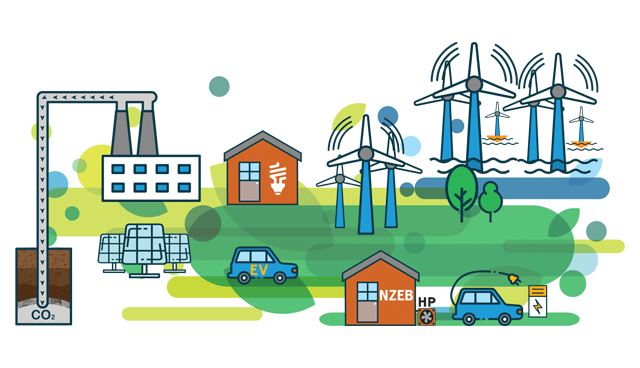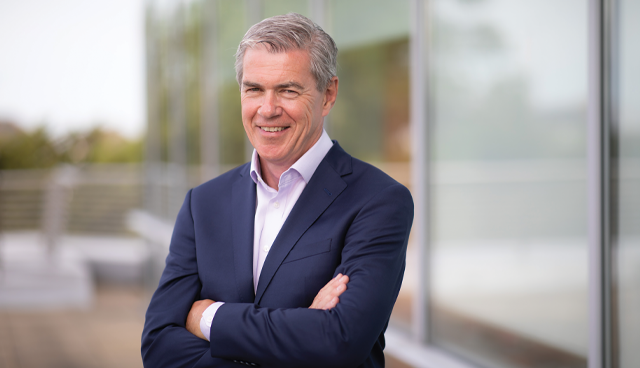Scenario planning: Ireland’s three possible carbon futures

One of EirGrid’s main roles is to develop the electricity transmission grid so that it can meet the long-term needs of society. Key to this is considering a range of possible ways that electricity supply and consumption may change in the future; what EirGrid refers to as scenario planning. Ciarán Rabbitt, Senior Engineer, Scenario Planning at EirGrid, explains.
Scenario planning allows us to assess the electricity system against a range of potential energy transition futures. It helps us to analyse projected demand levels and to ensure a long-term, sustainable energy future for Ireland.
We use scenarios to test the performance of the transmission system against the changes to electricity demand, generation, storage and interconnection developed in our scenarios. We also use our scenarios throughout our grid development process, ensuring that needs remain valid as the electricity transmission grid changes over time and more information becomes available.
This scenario planning work is captured in “Tomorrow’s Energy Scenarios”, which outlines a range of credible pathways for Ireland’s clean energy transition, with a focus on what they mean for the electricity transmission system over the next 20 years. The scenarios are reviewed every two years to include the most up-to-date information and in June EirGrid opened a consultation on its latest analysis, Tomorrow’s Energy Scenarios 2019.
The new research identifies three possible scenarios:
Centralised Energy — A plan-led world in which Ireland achieves a low carbon future;
Delayed Transition — A world in which the pace of change is not sufficient to meet climate objectives; or
Community Action — One where citizens recognise climate change as a risk and take appropriate action.
Centralised Energy is a world in which Ireland achieves a low-carbon future. There is a step change in the uptake of electrified transport and heating. For electric vehicles cost parity occurs over the next five years and electrification of the housing stock occurs in tandem with improved efficiency due to deep retrofitting. Although uptake is significant, there is only a modest level of grid flexibility offered from consumer technologies.
Renewable electricity is mainly generated by large-scale sources. The diversity of the renewables mix increases due to reducing technology costs and auction designs. Carbon capture and storage is developed to decarbonise fossil fuel generation.
Delayed Transition is a world in which decarbonisation progress is made, but the pace is not sufficient to meet climate objectives. Policy measures fail to break down barriers to a systematic clean energy transition. Consumer behavioural change is modest, with a gap remaining between climate change awareness and action.
This means that the shift to electrified transport and, in particular, heating is delayed. Deployment rates of renewable and low-carbon technologies are slower than required.
Community Action reflects a world of sustainability and an economy aimed at minimising waste and making the most of resources. Citizens recognise climate change as a risk and take appropriate action. Policy measures are embraced by energy consumers and communities, leading to a more decentralised electricity system. Centralised decarbonisation solutions still play an important role in moving toward energy and climate targets. Consumer adoption, the Internet of Things and artificial intelligence bring a change in consumption patterns and help manage the daily peak in electricity demand.
There is significant growth in generation connected to the low-voltage electricity network. This micro generation is accompanied by battery storage, yielding high levels of self-consumption.
When developing scenarios, we identify key factors that will influence the future usage of the electricity grid, be that location, size, quantity, type and pattern of electricity generation and consumption. The characteristics selected for instructing the high-level design of TES 2019 are decarbonisation, decentralisation and digitalisation, due to their significant influence on the future electricity system.
Decarbonisation refers to the level of abated carbon dioxide (CO2) emissions. A higher level of decarbonisation yields lower CO2 emissions released into the atmosphere. Reducing electricity system CO2 emissions can be achieved through renewable energy, the deployment of carbon capture and storage and energy efficiency measures.
In order for the electricity sector to support Ireland equitably contributing to the Paris Agreement, research suggests that the electricity sector would need to be CO2 neutral by 2040.
Decentralisation refers to the size and proximity of energy production in relation to the consumer. Increased decentralisation means that more energy will be produced by smaller scale units positioned close to consumers. This means generation is connected to the distribution network, with micro generation playing a considerable role.

In contrast, a more centralised world means that more energy will be produced by larger scale units connected to the transmission system.
Digitalisation refers to the role played by digital technology and data. A higher level of digitalisation means a higher utilisation of smart meter data, contributing to a greater Internet of Things network. This enables the participation of consumer-owned technologies, such as rooftop solar photovoltaic panels, electric vehicles and other residential loads.
For example, owners can coordinate their devices in order to reduce electricity bills, while also offering services to the system operators. Higher digitalisation also yields higher data centre growth, due to increased data usage. One thing that we know for sure is that electricity demand will significantly increase over the next couple of decades. According to EirGrid’s analysis, demand will jump by one third over the coming decade, with much of the increase fuelled by data centre growth.
The generation portfolio of the future will also be different from today, with the EU Clean Energy Package allowing for the promotion of “renewable electricity by implementing cost-effective national support schemes subject to State aid rules”.
Much of Ireland’s electricity is likely to be from weather-dependent renewable sources. This has resulted in a growth in demand for new types and sources of system services, the provision of grid stabilising services that are necessary when renewable generation is high.
The publication of Tomorrow’s Energy Scenarios 2019 came one week after the launch of the Government’s Climate Action Plan. This sets a target of 70 per cent of electricity consumption to come from renewable sources by 2030, more than double the figure achieved in 2018.
EirGrid Chief Executive Mark Foley adds: “More than doubling the amount of renewable energy on the power system represents a significant challenge that will require investments in the transmission grid and meaningful engagement with communities throughout Ireland.
“We will use our scenarios throughout our grid development process, ensuring that needs remain valid as the electricity transmission grid changes over time and more information becomes available.”
Consultation on Tomorrow’s Energy Scenarios 2019 closed in August and feedback will be used when developing the final publication. System Operator for Northern Ireland (SONI) will begin consultation on its Tomorrow’s Energy Scenarios 2019 later this year.
T: 01 237 0819
E: ciaran.rabbitt@eirgrid.com
W: www.eirgrid.com






